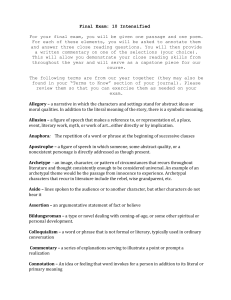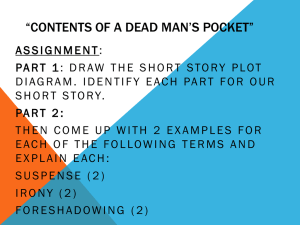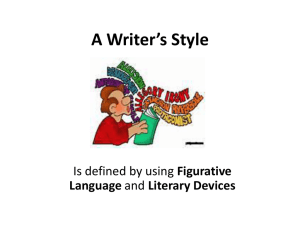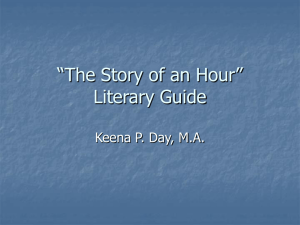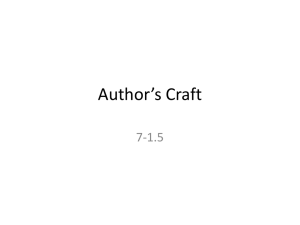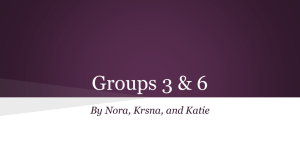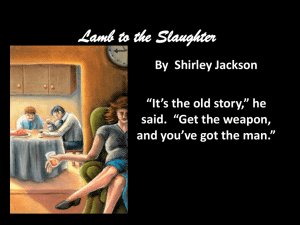Literary terms
advertisement
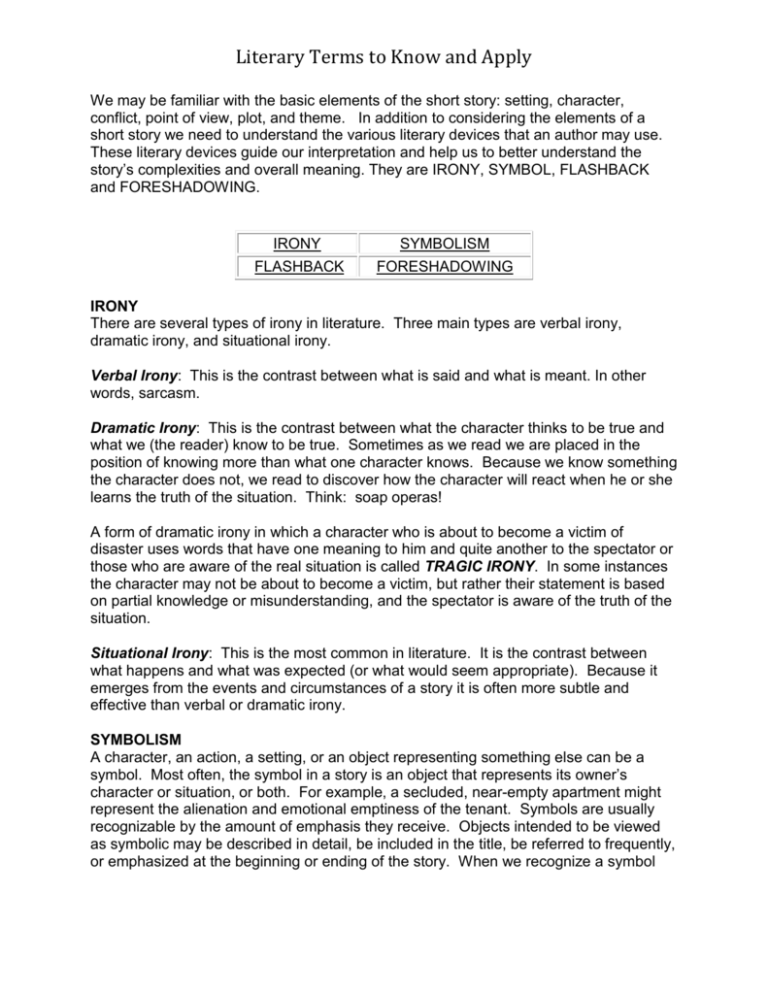
Literary Terms to Know and Apply We may be familiar with the basic elements of the short story: setting, character, conflict, point of view, plot, and theme. In addition to considering the elements of a short story we need to understand the various literary devices that an author may use. These literary devices guide our interpretation and help us to better understand the story’s complexities and overall meaning. They are IRONY, SYMBOL, FLASHBACK and FORESHADOWING. IRONY SYMBOLISM FLASHBACK FORESHADOWING IRONY There are several types of irony in literature. Three main types are verbal irony, dramatic irony, and situational irony. Verbal Irony: This is the contrast between what is said and what is meant. In other words, sarcasm. Dramatic Irony: This is the contrast between what the character thinks to be true and what we (the reader) know to be true. Sometimes as we read we are placed in the position of knowing more than what one character knows. Because we know something the character does not, we read to discover how the character will react when he or she learns the truth of the situation. Think: soap operas! A form of dramatic irony in which a character who is about to become a victim of disaster uses words that have one meaning to him and quite another to the spectator or those who are aware of the real situation is called TRAGIC IRONY. In some instances the character may not be about to become a victim, but rather their statement is based on partial knowledge or misunderstanding, and the spectator is aware of the truth of the situation. Situational Irony: This is the most common in literature. It is the contrast between what happens and what was expected (or what would seem appropriate). Because it emerges from the events and circumstances of a story it is often more subtle and effective than verbal or dramatic irony. SYMBOLISM A character, an action, a setting, or an object representing something else can be a symbol. Most often, the symbol in a story is an object that represents its owner’s character or situation, or both. For example, a secluded, near-empty apartment might represent the alienation and emotional emptiness of the tenant. Symbols are usually recognizable by the amount of emphasis they receive. Objects intended to be viewed as symbolic may be described in detail, be included in the title, be referred to frequently, or emphasized at the beginning or ending of the story. When we recognize a symbol Literary Terms to Know and Apply and understand its meaning or meanings we see more clearly what the writer chose to emphasize. FLASHBACK: This is a writers’ technique in which the author interrupts the plot of the story to recreate an incident of an earlier time (goes back in time; like giving the reader a memory). This device is often used to provide additional information to the reader. FORESHADOWING: This is a writers’ technique in which the author provides clues or hints as to what is going to happen later in the story. It’s like the music in a scary movie when we know that something bad is about to happen. THEME: Underlying idea of a piece of writing or the message which the author wished to emphasize or portray. IMAGERY: The key to good imagery is engaging all five senses. Here are some examples of words specific to the five sensory systems: Visual Auditory Kinesthetic Olfactory Gustatory picture flash bright sharp clear see light dark large blue scream shout listen tone whisper ring utter nasal squeal quiet feel warm grasp sharp peaceful cold rugged joyful fuzzy hard pungent fragrant sweet dank rich aroma stinky musty rotten odor essence sweet sour salty bitter fresh juicy bland burnt zesty tangy Visual To evoke visual imagery, visualize the following: A shape: circle, triangle, square An oak tree A rose A sailing boat A button A computer Auditory To evoke auditory imagery, imagine the following: The wind blowing through the trees The ring on your telephone The sound of your computer keyboard Scales played on a guitar Water lapping on a lake shore Literary Terms to Know and Apply Olfactory To evoke olfactory imagery, conjure up the following smells: Petrol fumes Newly baked bread Chlorine New mown grass Freshly brewed coffee Gustatory (taste) To evoke gustatory imagery, imagine the taste of: Sugar Bananas Salt Lemon Toothpaste Kinesthetic Kinesthetic imagery can be further divided into: sense of touch, temperature, movement, and feelings. Touch - imagine the feelings of: Standing barefoot on a sandy beach Running your fingertips on satin fabric Holding a smooth pebble Temperature: Sunlight falling over your arm Holding an ice cube Stepping into a warm bath Movement - feel yourself engaged in an activity: Swimming Running on grass Throwing a ball Feelings - what does it feel like in your body to be: Peaceful Angry Sad Calm Happy These are the main five types of imagery. Engage as many senses as you can when you are doing visualization or guided imagery. Literary Terms to Know and Apply Literary Devices Allegory A form of literature in which objects and persons are equated with meanings that lie outside the story itself Alliteration The deliberate repetition of sounds or syllables, especially initial consonants, for stylistic effect (e.g., recreational reading and writing) Allusion A brief reference, explicit or implicit, to a place, person, or event; the reference may be historical, literary, religious, or mythological. Anachronism Assignment of an event, a person, an object, language – anything, in fact – to a time when that event, person, or object was not in existence Archetype Prototype, the original pattern or mode, the reference, the set, the example Aside The character shares their thoughts with the audience; though other characters are on stage, they are unaware of what that character is saying. Assonance The deliberate repetition of similar vowel sounds for stylistic effect (e.g., feel/clean). Cacophony A generally harsh unpleasant, clashing combination of sounds (the truculent Turk stood quite quiet) Catharsis The purification of the emotions through the spectator’s imaginative participation in the sufferings of the tragedy’s characters, and the feeling of emotional relief and exaltation induced by tragic literature or art Cliché A trite phase: one that has lost its force through overuse (last but not least) Connotation Includes all the ideas that are suggested by the term (home=comfort, love, & security) Consonance The agreement of ending consonant sounds when the vowel sounds differ (nature/feature) Denotation The exact meaning of a word (home denotes the place where one lives) Diction The choice of words or phrases in speech or writing; the particular words chosen to express an idea Dramatic Irony Words of a character in a play carry a meaning unknown to him/her, but understood by the audience. Euphemism A mild, even vague expression used instead of a harsh, unpleasant one (perspire instead of sweat; lay to rest instead of bury) Euphony Produced by a generally pleasing combination of sounds (a damsel in distress) Foil A character whose behavior and qualities set off or enhance those of another figure Literary Terms to Know and Apply Idiom A group of words that, through usage, has taken on a special meaning different from the literal meaning (e.g., Keep your shirt on! or It’s raining cats and dogs). Imagery Descriptions and figures of speech (e.g., metaphors, similes, and other figurative language) used by writers to create vivid mental pictures in the mind of the reader. Hamartia In tragedy, an error of judgment, made as the result of ignorance or human weakness, which contributes to the downfall of the hero. (A.K.A. tragic flaw) Hyperbole A literary device in which exaggeration is used deliberately for effect or emphasis (e.g., a flood of tears, piles of money Juxtaposition Combined, union – placing of pictures or text side by side to examine the similarities or differences present Metaphor A comparison, either expressed or implied, without the use of like or as Moral Practical lesson taught by a piece of writing Onomatopoeia The use of a word having a sound that suggests its meaning (e.g., splash, murmur, buzz, twitter) Oxymoron A combination of words with contradictory meanings, used deliberately for effect (e.g., delicious torment, living death) Paradox A statement that either seems to or actually does contradict itself (ex. If you don’t want to lose him, let him go.) Parody A work mimicking the language, style, or ideas of another for comic or satiric effect (ex. “To study or not to study, that is the question.” Is taken from “To be or not to be, that is the question”.) Pathetic Fallacy The atmosphere/surroundings reflect the mood/feelings of the character(s) Pathos A quality which incites pity, sorrow, or sympathy in the reader Personification The giving of personality or life to inanimate objects or ideas Point of view In fiction, the position of the narrator in relation to the story and audience (e.g., a limited, omniscient, third-person, or first-person narrator; multiple narrators) Précis A concise summary of the ideas in a written text Rhetorical question A question asked not for information but for dramatic effect. The answer may be selfevident (Why should I care what they think?) or immediately provided by the questioner (What should be done? Well, first we should...). Satire Literary Terms to Know and Apply A form of writing in which human follies and vices are help up to ridicule, generally with the intention of reform. Simile A comparison using “like” or “as” Soliloquy A speech of a character delivered while the speaker is alone on stage; he/she informs the audience what he/she is thinking Slang Very informal language patterns or vocabulary used by particular groups, or in special contexts, or to reflect trends. Tone A manner of speaking or writing that reveals the speaker’s or author’s attitude towards a subject and/or audience. Theme Underlying idea of a piece of writing or the message which the author wished to emphasize or portray.
